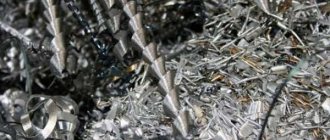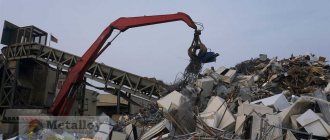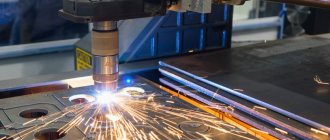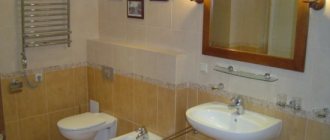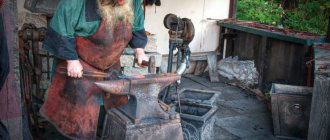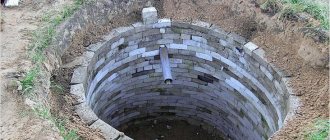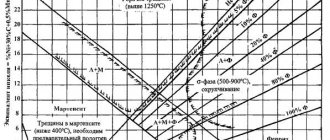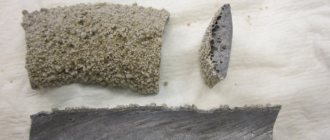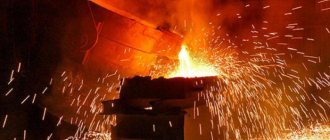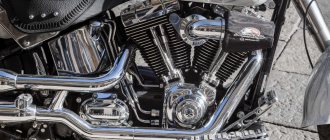Scrap ferrous metals are readily accepted by many processing companies, because it valuable source of secondary raw materials.
After processing, it is used to produce various products that can be used in many areas of the economy.
For the population, scrap metal is a way to earn extra money.
Many bring old batteries, pipes and other metal that previously served in everyday life to ferrous metal collection points, and some are professionally engaged in searching and digging for ferrous metal.
Be that as it may, recycling ferrous metal is an important aspect in preserving the environment and conserving natural resources .
In this article we will step by step consider the process of ferrous metal processing: from sorting to production of finished products.
Sorting
Ferrous metals include:
- steel,
- cast iron,
- iron.
Scrap at enterprises is sorted according to the following criteria :
- dimensions;
- separation by chemical composition.
Large organizations for recycling metal recyclables automate the sorting process, significantly speeding it up.
First from scrap metal:
- remove impurities ,
- remove garbage .
If work is carried out with large metal structures, then loading equipment is used for sorting.
Sorting by chemical composition is carried out taking into account the quality indicator of the metal, as well as its type. In addition, during sorting, separation can take place based on the content of alloying and carbon components .
In small enterprises, sorting is often done manually , immediately at the acceptance stage. Scrap is divided into:
- heavy;
- easy;
- moderate severity.
Also shared
- large-sized elements,
- small-sized.
Sorting is necessary to prepare scrap for melting .
For correct processing, the metal is cut into fragments before melting.
Equipment and materials you will need
In order to melt metal, you need to buy the following components for manufacturing:
- fire brick;
- nails;
- transformer;
- copper wire;
- graphite;
- mica;
- asbestos and cement tiles;
- gas-burner;
- crucible.
The dimensions will vary depending on the wishes of the person collecting it. It is better to create a small furnace for melting metals if you want to use it only for your needs. You will spend less time making it, and a small amount of kilowatts will be spent heating it. If you do it using diesel fuel or coal, then do not forget about installing thermal insulation and air supply.
Homemade crucibles
Metals such as iron, nickel, tin, and copper are melted in an electric furnace. The output voltage in an electric furnace should be greater, which means the distance between the electrodes will increase. Brushes from an electric motor are suitable instead of electrodes.
Cutting and cutting
When large-sized scrap ferrous metals are brought to the enterprise, its processing begins immediately after acceptance. Employees of the collection point cut large pieces with special cutting tools, giving the scrap metal the required size.
If the pieces of metal are small in size and weight, then they are pressed into briquettes using presses (their design is the same as presses for waste paper, only they have greater pressure). Metal sheets are also subjected to shredding - crushing in shredders. The essence of the process is the same as when recycling documents - cutting sheets into fragments.
In order to give the pieces a marketable shape, enterprise workers use shear presses for cutting. In this case, the scrap is cut into pieces, immediately after which pressing and shipping are carried out.
Advantages and disadvantages of recycling
Positive sides:
- Improving the overall environmental situation.
- Reduced level of demand for ore mining.
- Reducing energy costs for the production of metals and alloys.
- Reducing the amount of metal dust in the air.
For processing and storing scrap metal, large workshops with industrial equipment are needed. To increase the efficiency of the production process, it is necessary to open additional scrap metal collection points, which requires additional investments and an expansion of staff.
Scrap metal collection (Photo: Instagram / chermetvlg34)
Cleaning
cleaned before being sent for remelting . The technology depends on what characteristics the scrap has. Crushing is widely used . It is carried out in a special chamber into which large elements are placed.
To remove from the surface
- dirt,
- non-metallic impurities,
- dust particles,
separation technology is used . Its essence lies in exposing the object to a powerful air flow, due to which all foreign elements are blown away from the surface and removed from the crushing chamber.
There is another technology that is widely used in processing plants.
We are talking about the use of a magnetic separator ; it can be used as part of a conveyor.
The crushed metal is attracted by a powerful magnet, thus sifting out non-metallic impurities .
drum-type magnetic separator is shown in the picture. There are also flat magnetic separators that can also be used in this industry. Magnet power may vary.
Of course, such technologies are the prerogative of large enterprises that can afford to invest in the purchase of new processing lines. Small collection points carry out sorting and cleaning using manual labor .
Problems in recycling scrap metal
Despite the economic efficiency of existing technology, recycling scrap metal has its own difficulties. The main problem is considered to be a large amount of waste. When using gas cutters, irrecoverable losses reach 3-5 percent. The use of more advanced technologies reduces waste, but the equipment costs significantly more.
Sorting scrap metal involves the allocation of large areas. Accordingly, reception points and sorting shops must have the appropriate area and height. The remaining problems are minor and do not affect the growing popularity of recycling. The benefits of scrap melting far outweigh the disadvantages and complications.
Preparing for melting
After cleaning of the scrap is completed, it is sent for smelting . Before this, pieces of the desired shape are pre-formed from the metal. For this purpose the following are widely used :
- plasma cutters;
- shredders;
- mechanical cutters.
The finished product is strips of metal , which are packaged or made into briquettes. If after crushing the scrap was cleaned, then cutting is excluded from the cycle.
Many enterprises include a stage in the process
- briquetting,
- metal packaging.
To form packaged briquettes, the workshop is equipped with pressing equipment (usually hydraulic or mechanical installations) with a baling function (baling presses).
Pressed metal in briquettes is convenient to store and transport , it is easy to load and takes up little space in the warehouse and in freight transport.
What types of scrap cannot be recycled?
Metal is not always suitable for reuse. Rusted scrap metal is not suitable for melting. Moderate rust is acceptable, but the rules of a particular collection point may prohibit the acceptance of such products.
All scrap metal must undergo radiation control. If the dosimeter shows radiation close to the maximum permissible standards, recycling of such metal is possible after additional cleaning. Scrap that exceeds background radiation standards is subject to burial.
High levels of radiation are typical for nuclear icebreakers, submarines, equipment of nuclear power plants, icebreakers, and submarines. Scrap metal that has been stored for a long time in conditions of high radiation, as well as some types of medical equipment, are carefully checked.
Remelting in smelters
Smelting plants are specialized enterprises whose workshops are equipped with melting units . They can be electric or plasma:
- Electric ones have higher efficiency, are more productive and are safe to use.
- Plasma ones have a more affordable price, but their efficiency is lower.
Ferrous metals from the melt are sent to manufacturing plants where the metal is reused.
Modern remelting technology consists of several stages.
scrap metal is poured
into a steel bucket, on the surface of which a special coating has been applied .
Then molten cast iron is poured purged with oxygen .
The quality of steel is deteriorated by its constituents:
- sulfur;
- silicon;
- phosphorus.
It is sulfur and phosphorus that cause steel to break at low and high temperatures. For this reason, it is important to get rid of unnecessary impurities at the scrap melting stage. To burn them out, special additives are used.
The fewer foreign components the steel contains, the better its quality. You can give it special properties by including
- vanadium,
- chromium,
- cobalt,
- nickel
Melting furnaces have different capacities. Modern installations are fully automated , this makes it possible to control the technological process at all its stages.
At large enterprises, scrap metal is not only melted down, but also rolled into ingots . From an economic point of view, this is more profitable than simple recycling. Such products can be sold on the market in a short time, so large enterprises have high profitability.
If you follow the production technology, then the steel produced at smelting plants will be no worse than the products that were obtained from ore .
Scrap metal processing stages
The prospects for increasing the volume of scrap processing are obvious. For Russian and foreign enterprises, this approach is becoming increasingly relevant. In addition to ferrous metal, technologies for processing non-ferrous metals are actively developing. Similar raw materials are found in batteries and accumulators, household appliances. The technical capabilities of enterprises make it possible to extract valuable raw materials from devices and reuse them.
The standard technology for processing scrap metal consists of the following stages:
- at the acceptance stage, primary points weigh the scrap metal and make payment;
- sorting involves the distribution of scrap metal by type and profile;
- for ease of transportation and processing, the material is cut into separate fragments;
- purification from impurities is a prerequisite for obtaining high-quality raw materials;
- The final stage is remelting; the resulting rolled metal can be reused.
The best option is to receive scrap and sort it at the same time. This approach significantly reduces labor costs and speeds up the processing process. Some companies do not always sort scrap efficiently; as a result, metal with impurities is received for remelting.
A full processing cycle at one enterprise is the best option. The company accepts primary raw materials and supplies finished metal products to customers. The company is interested in obtaining high-quality products, so it carefully monitors compliance with technology. The legislation stipulates the requirement for radiation monitoring of scrap. Raw materials are checked at the stage of reception, pre-sale preparation and before sale.
Equipment used
scrap processing equipment is used namely:
- scrap scissors;
- baling and briquetting presses;
- portable hydraulic shears;
- plasma cutting units;
- sorting and grinding equipment;
- dispensers;
- reloaders;
- shredders;
- magnetic separators.
Don’t forget about cranes or lifting magnets - they are used to deliver material.
Baling presses are necessary for the preparation of waste, for example:
- wires,
- sheet scraps.
The press consists of a chamber with plungers; the installation is equipped with hydraulic equipment and a mechanism for loading scrap into the chamber. During the packaging process, waste is compressed in three planes, thus forming compact bags.
The recycling process consists of loading metal waste into a chamber for subsequent pressing; the processing is completed by storing the bags . To service the installation, mechanized equipment is used, for example:
- lifting magnets,
- taps.
A shear press is an installation in which the transverse wall of the chamber acts as a knife beam. Metal waste is moved under the knives using a feed mechanism, then the scrap is fixed with a stamp.
Alligator scissors are a lever device that can be used to cut:
- pipes,
- armored cable,
- rolled steel.
A clamping device is used to fix the scrap, and a roller is installed to direct the metal under the knife.
Hydraulic shears - consist of:
- beds,
- feeder,
- clamping and cutting mechanism.
The installation is equipped with an electric drive and a hydraulic drive. Hydraulic shears can effectively cut scrap into pieces.
The processing process consists of preparing the pieces and loading them into scissors. Next, the cutting process itself is carried out, then the resulting pieces are sorted by size. You can see hydraulic shears in the photo:
Mini-plants for processing scrap - with their help, you can process ferrous scrap, and then immediately produce many types of finished products , for example:
- construction fittings,
- wire rod.
In addition, you can set up the release:
- corner;
- I-beam;
- channel;
- grinding balls.
Remelting of waste occurs in electric arc furnaces and induction-type .
By installing such a mini plant, you can produce from 60 thousand to 1 million tons of products every year.
The steelmaking plant is designed to produce tool and low-alloy steel. Production of structural steel is also possible.
Information with current prices , as well as links to the seller’s websites, is presented in the table:
Equipment used for melting ferrous scrap
| Name | Model | Price | Website |
| baling presses | Rico S-12, Rico S-26, Rico S-40 | from 500 thousand - 2.4 million rubles | press-rico.rf |
| BV1330, B1334, BG1334, B132, B122 | 700 thousand - 2.5 million rubles | impexpress.ru | |
| briquetting presses | AYMAS VR-80 | 63 thousand rubles | equipnet.ru |
| alligator scissors | AYMAS HM52, Н2732, Н313, Н315, RIKO A-500E, RIKO A-600 | from 220 thousand rubles | vlos.name |
| electromagnets | EMG078, EMG230 | from 450 thousand rubles | bars-service.ru |
| magnetic separators | MCP - 1, MCP - 2 | negotiable | magnity-magsy.ru |
Applications of recycled ferrous metal
Scrap metal after melting acquires the properties inherent in primary raw materials. It produces high-quality rolled metal that can be used everywhere .
Mining metal ores is a complex business, so scrap recycling is much more profitable for the industry.
It allows you to achieve:
- Saving energy resources.
- Reducing negative impact on the environment. Mining raw materials from ore causes 10 times more harm .
- Preservation of natural reserves (iron ore).
- Accelerating the extraction of raw materials. Scrap recycling is a faster process than mining and using iron ore.
After recycling metal waste, ferrous metals can be used to create any products needed by humans.
This video shows the operation of a ferrous metal processing line:
Business
After the collapse of the USSR and the introduction of a capitalist economic system, private business began to grow and expand in the vastness of the former republics. And one of its types is the acceptance of ferrous and non-ferrous scrap metal from citizens. In addition, entire enterprises were subjected to recycling, where huge amounts of iron had accumulated over the past years or periods of stagnation.
And in our time, this business is widespread; in almost every locality you can find a place where ferrous or non-ferrous iron is accepted. Although prices are not squeezed into a rigid framework, they still differ slightly depending on the region.
